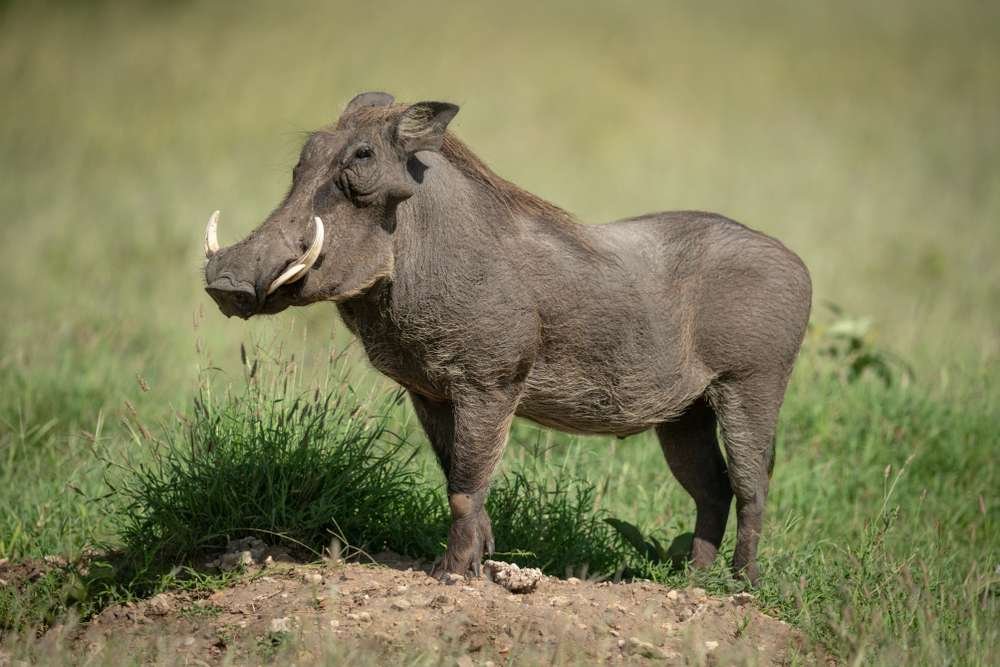Common Warthog
( Common warthog )
- Phacochoerus africanus
- IUCN Status: Least Concern
- Trend: decreasing

- Kingdom: Animalia
- Phylum: Chordata
- Class: Mammalia
- Order: Artiodactyla
- Family: Suidae
- Genus: Phacochoerus
Share:
General Information
The common warthog (Phacochoerus africanus) is a wild member of the pig family (Suidae) found in grassland, savanna, and woodland in sub-Saharan Africa. This is the most common subspecies of warthog in Zambia. It is found throughout the country, in a variety of habitats, including savannas, forests, and woodlands.
Fun Facts
Common warthogs are known for their ability to wallow in mud. This helps them to keep cool and to protect their skin from parasites. Common warthogs are an important part of the Zambian ecosystem. They help to disperse seeds, control populations of insects, and provide food for other animals. They have a unique way of sleeping. Common warthogs sleep in burrows that they either dig themselves or take over from other animals, such as aardvarks. They sleep with their heads facing the entrance to the burrow so that they can quickly escape if they are threatened. They have a symbiotic relationship with birds. Common warthogs have a symbiotic relationship with certain birds, such as the yellow-billed hornbill. The birds eat parasites and insects off of the warthogs, while the warthogs benefit from having their pests removed.
Description
The common warthog is a medium-sized species. Common warthogs are characterized by their long snouts, tusks, and distinctive markings. It closely resembles a pig but has two pronounced tusks protruding from the mouth and curving upwards. They are also dark skinned and hairy with a more aggressive temperament.- Shoulder height: 63.5 to 85 cm
- Length: 0.9 to 1.5 m
- Weight: 45 to 150 kg
Ecology & Behaviour
The common warthog is the only pig species that has adapted to grazing and savanna habitats. Its diet is omnivorous, composed of grasses, roots, berries and other fruits, bark, fungi, insects, eggs and carrion. The diet is seasonably variable, depending on availability of different food items. During the wet seasons, warthogs graze on short perennial grasses. During the dry seasons, they subsist on bulbs, rhizomes, and nutritious roots.
Warthogs are powerful diggers, using both their snouts and feet. When feeding, they often bend their front feet backwards and move around on the wrists. Calloused pads that protect the wrists during such movement form early in the development of the fetus. Although they can dig their own burrows, they often occupy abandoned burrows of aardvarks and other animals. The common warthog commonly reverses into burrows, with its head facing the opening and ready to burst out if necessary. Common warthogs will wallow in mud to cope with high temperatures and huddle together to cope with low temperatures.
Although capable of fighting (males fight each other during mating season), the common warthog’s primary defense is to flee by means of fast sprinting. When threatened, Warthogs can run speeds of up to 48 km/h, will run with their tails sticking up and will enter their dens rear first with tusks facing out. The common warthog’s main predators are humans, lions, leopards, cheetahs, crocodiles, wild dogs and hyenas. Birds of prey such as Verreaux’s eagle owls and martial eagles sometimes prey on piglets. However, a female common warthog will defend her piglets aggressively. On occasion, common warthogs have been observed charging and even wounding large predators. Common warthogs have also been observed allowing banded mongooses and vervet monkeys to groom them to remove ticks.
Conservation
They are listed as a, “least concern” on the International Union for Conservation of Nature (IUCN Red list)
Distribution & Habitat
Common warthogs are not territorial, but instead occupy a home range. Common warthogs live in groups called sounders. Females live in sounders with their young and with other females. Females tend to stay in their natal groups, while males leave, but stay within the home range. Sub-adult males associate in bachelor groups, but males live alone when they become adults. Adult males only join sounders with estrous females. Warthogs have two facial glands: the tusk gland and the sebaceous gland. Common warthogs of both sexes begin to mark around six to seven months old. Males tend to mark more than females. They mark sleeping and feeding areas and waterholes. Common warthogs use tusk marking for courtship, for antagonistic behaviors, and to establish status.
No donation to this project yet.
| M | T | W | T | F | S | S |
|---|---|---|---|---|---|---|
| 1 | 2 | 3 | ||||
| 4 | 5 | 6 | 7 | 8 | 9 | 10 |
| 11 | 12 | 13 | 14 | 15 | 16 | 17 |
| 18 | 19 | 20 | 21 | 22 | 23 | 24 |
| 25 | 26 | 27 | 28 | 29 | 30 | |


